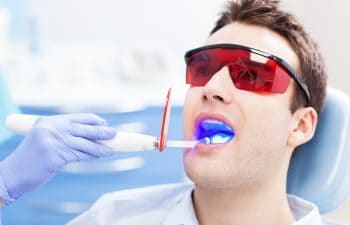
There was a time when a trip to the dentist was a grueling experience, even if you were not afraid of the procedures. The dental chair itself was an uncomfortable contraption that was pumped up by the dentist’s foot. The handpieces used to drill teeth were run by belts and pulleys. Not only did they make a terrible sound, they rattled your head as the drill bit cleaned out the cavity.
During those days, some parts of the experience were not great for the environment either. Dental x-rays were developed using chemicals and the film packet on which the final image was developed had a lead sheet. X-ray machines, though safe enough, still put out more radiation than the modern digital machines of today.
If you haven’t been to the dentist in a long time, you are in for a few surprises. Today’s dentist has a variety of options to help keep your teeth and gums healthy and looking beautiful. Techniques, instruments and materials have advanced in ways that may amaze you.
High-Tech X-Rays
The traditional radiograph is now replaced with digitized x-rays. Traditional radiographs used chemicals to develop the image. The film had to be developed in a dark room in different stages before it could be viewed by the dentist. Digital x-rays do not require the same process.
Digital x-rays take only seconds. Instead of film that needs chemical solutions to develop, an electron censor or phosphor plate is placed in the patient’s mouth. This captures the image, which is then relayed to a computer for viewing. In addition to almost instantaneous viewing, the digital image can be stored on the computer. This makes it easier to be compared with earlier or future images of the same area.
Sometimes a dental team comprised of the general dentist and dental specialists such as an oral surgeon or orthodontist need to see the same image in order to carry out certain procedures. Digital x-rays make it easy to share such information with the entire team without needing duplicates or taking chances on the image being lost in transit.
Sensor and phosphor plates are more sensitive to x-rays than the traditional film that was used in the past. Because of this, the dose of radiation that patients are exposed to is greatly reduced. This is particularly good news for those who have concerns about exposure to radiation.
Digital x-rays can reveal the extent to which a cavity is affecting the tooth. They are also used to examine the bone below the teeth. Problems with the bone can be detected and corrected as needed. The x-rays are also used to determine the placement of dental implants. Implants require precise placement to prevent failure and digital x-rays help ensure correct placement.
Root canal therapy also uses x-rays. The dentist or endodontist performing the procedure uses the x-ray to make sure the root canal is sufficiently cleaned out and sealed off properly. The x-ray also shows the extent to which an abscess has formed and gives the dentist an idea of the proper treatment for the infected tooth.
Lasers for Tooth Cavity Detection
Traditionally, dentists have used an instrument called an “explorer” along with a mouth mirror to find cavities. If the tip of the explorer sticks in a pit or hole in the tooth, the dentist will determine if there is decay present. Today, many dentists use a diode laser to detect tooth decay in addition to the explorer.
This dental instrument is primarily used on teeth that do not already have fillings. The diode laser uses light to detect cavities. The light energy is reflected off the tooth in different ways, depending on whether or not decay is present. Decay is revealed by fluorescence of the tooth. The more fluorescence, the more decay. This method of identifying problem areas is very helpful for hard-to-see areas and tiny spots of decay that have not yet developed into full-blown cavities. This technology allows the dentist to establish a baseline for healthy teeth and to monitor problem areas.
Although the diode laser is very helpful in detecting cavities, it is not as accurate on teeth that already have fillings. Dentists use the laser in conjunction with traditional methods of detecting cavities.
Computer Crowns
Not long ago, getting a crown for a tooth meant a few trips to the dentist before your tooth was finally fitted with a crown. Sometimes the crown did not fit properly due to problems with the impression or mold. Now, computer generated images and manufacturing make getting a crown fast. Computer assisted design and computer assisted manufacture (CAD/CAM) allow the dentist to create a crown in one day. These types of crowns are called CEREC crowns. CEREC is an acronym for Chairside Economical Restoration of Esthetic Ceramics.
CAD/CAM technology eliminate the need for impressions, temporary crowns and trips back and forth to the dentist. With this new technology, the tooth is prepped for the crown and a picture is taken with an intraoral scanner to create a digital impression. This is sent to the CAD/CAM software machine, which creates a digital crown. The resulting image gets relayed to a machine in the office that creates the crown out of a ceramic block. This process takes about 15 minutes. Once the crown has been manufactured, the dentist will polish the crown and cement it to the prepared tooth.
CEREC crowns eliminate the need for multiple visits to the dentist, which saves you time and money. Dental insurance usually covers CEREC crowns. You may want to check with your insurance provider first to find out how much of the cost will be covered.
Composite Filling Materials
Although composite filling material has been in use since the 1960s, today’s composites are more durable and better matched to your natural tooth color. They are more translucent than past materials. This helps to create a more natural-looking restoration. The durability of today’s composites also allows them to be used in molars. Composites are bonded to the tooth structure. This gives them a better seal than traditional metal fillings.
Improved Dental Veneers
Believe it or not, dental veneers have been around for a over one hundred years. Some early versions were removable. Movie stars used veneers to create the perfect smile for the silver screen. Dental veneers are now popular not only for celebrities but everyone else as well. The veneers available today are thinner and stronger, thanks to the advancement of dental materials. Less healthy tooth structure is lost with thinner veneers, which means more of your natural tooth is left intact.
A More Pleasant Experience
Dental offices have evolved into more comfortable places overall. Drills are now high-speed, quieter and more efficient. The dental chair is more comfortable and amenities offered provide for a more relaxed and inviting atmosphere. Many dental offices also offer sedation for those patients who have dental phobias or heightened anxiety.
Dental technology continues to advance, providing better materials and instruments to make your visit to the dentist a pleasant and efficient experience. At Aesthetic & Implant Dentistry of Atlanta, we provide cutting-edge dentistry for our patients’ comfort and well-being. Contact us today to make an appointment for a dental examination or consultation.



